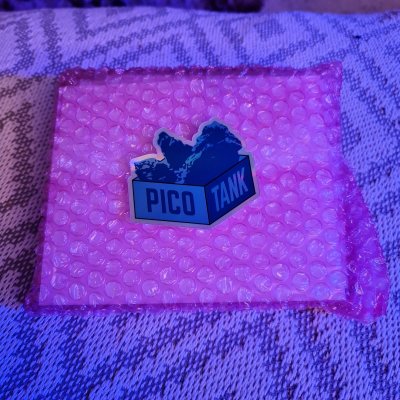Hello and welcome to my build thread for my 3.3L Pico Reef tank.
I started the build in January 2022. The tank is a 3.3L AIO Acrylic tank that you build yourself. Its made by a company called PTank. The tank is lazer cut into acrylic and comes in flat pack form which you then have to cement together yourself.

Although pretty daunting at first, it's much easier to put together then I had first thought it might be. The tank was cemented together using some Anglosol 1200 acrylic cement and with the aid of a couple of soup cans from the cupboard.


After leaving the cement to properly bond the acrylic together for 24 hours, the tank was finally ready to be leak tested. I found a tiny seam in the display that hadn't quite fully sealed so emptied the tank and reapplied some more cement before carrying on. Another 24 hours later and the tank was leak free.
I wanted to run the tank using only USB powered equipment so that I would only need one power socket from the wall to power a USB charging hub and then have all the equipment plugged into the hub. It took a bit of researching and looking around but I managed to find all the equipment I needed.
The light is a TMC Illuminair nano, a tiny 3w light that can be powered off usb and has a little inline controller to change colour and intensity. Although the light comes with a controller that can change the colour and intensity, it still needed to be switched on/off manually. I found a little device called a Sonoff smart usb switch that can be used to turn usb devices into smart devices including having a timer function. This allowed me to connect the light to my phone through an app and then setup a timer schedule so the light would turn on and off automatically.

The heater is also USB powered and has a built in thermostat too which can be set and then displays the current temperature of the tank.

The last piece of equipment needed for the tank was a return pump. I just picked up a cheap 200 LPH one online. You can find these USB powered ones just about anywhere.
While I was waiting for parts to arrive, I thought it would be a good idea to make a base for the tank to sit on and had some spare oak kitchen worktop offcuts laying around. The idea was too router out the underside and have all the equipment mounted on the underside so it was hidden away. A couple of hours on a Sunday afternoon and it was done.



The idea for the aquascape was to build a large rock pinnacle that would poke up out of the water, almost like a volcano and have a plant living on the top of it. I had seen a few other aquascapes that used tillansia or air plants to great success.
I used some spare bio media as a centre support structure for the scape and then used milliput to secure pieces of rock to build up the design.




I left the putty on the scape to harden off overnight and then tried to wrestle the aquascape into the tiny little display section once it was done.


I started the build in January 2022. The tank is a 3.3L AIO Acrylic tank that you build yourself. Its made by a company called PTank. The tank is lazer cut into acrylic and comes in flat pack form which you then have to cement together yourself.
Building The Tank

[How the tank is shipped out in flat pack form]
Although pretty daunting at first, it's much easier to put together then I had first thought it might be. The tank was cemented together using some Anglosol 1200 acrylic cement and with the aid of a couple of soup cans from the cupboard.
[Part way through building the tank]
[Leaving to dry overnight before leak testing]
After leaving the cement to properly bond the acrylic together for 24 hours, the tank was finally ready to be leak tested. I found a tiny seam in the display that hadn't quite fully sealed so emptied the tank and reapplied some more cement before carrying on. Another 24 hours later and the tank was leak free.
The Equipment
I wanted to run the tank using only USB powered equipment so that I would only need one power socket from the wall to power a USB charging hub and then have all the equipment plugged into the hub. It took a bit of researching and looking around but I managed to find all the equipment I needed.
The light is a TMC Illuminair nano, a tiny 3w light that can be powered off usb and has a little inline controller to change colour and intensity. Although the light comes with a controller that can change the colour and intensity, it still needed to be switched on/off manually. I found a little device called a Sonoff smart usb switch that can be used to turn usb devices into smart devices including having a timer function. This allowed me to connect the light to my phone through an app and then setup a timer schedule so the light would turn on and off automatically.

The heater is also USB powered and has a built in thermostat too which can be set and then displays the current temperature of the tank.
The last piece of equipment needed for the tank was a return pump. I just picked up a cheap 200 LPH one online. You can find these USB powered ones just about anywhere.
While I was waiting for parts to arrive, I thought it would be a good idea to make a base for the tank to sit on and had some spare oak kitchen worktop offcuts laying around. The idea was too router out the underside and have all the equipment mounted on the underside so it was hidden away. A couple of hours on a Sunday afternoon and it was done.
The Aquascape
The idea for the aquascape was to build a large rock pinnacle that would poke up out of the water, almost like a volcano and have a plant living on the top of it. I had seen a few other aquascapes that used tillansia or air plants to great success.
I used some spare bio media as a centre support structure for the scape and then used milliput to secure pieces of rock to build up the design.
[Building up the scape, piece by piece]
[Almost done but not quite high enough]
The rock is a man-made media called Cérock by ReefX. It's super porous and lightweight which was going to be perfect for what I needed.I left the putty on the scape to harden off overnight and then tried to wrestle the aquascape into the tiny little display section once it was done.




















